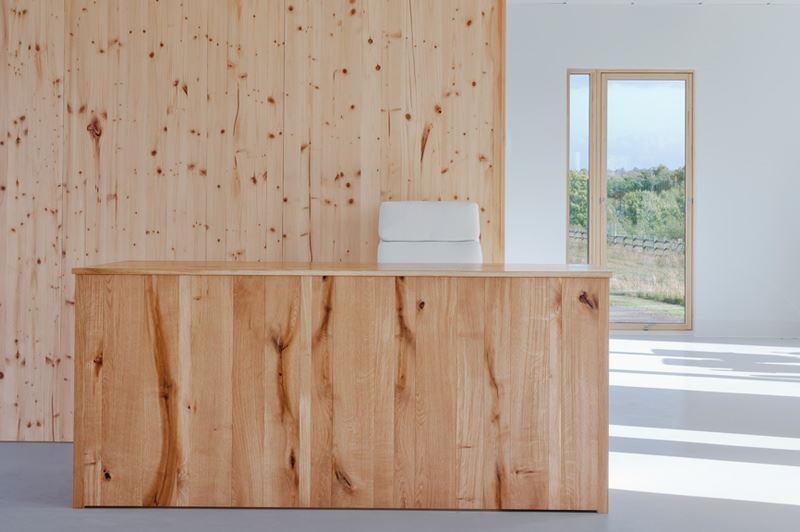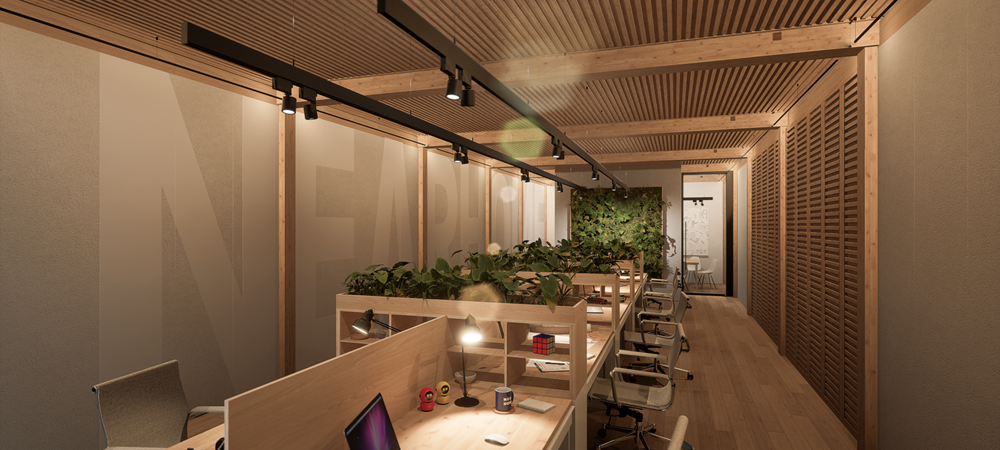Content
9 sustainable innovations at BE@COP26

A showcase of sustainable design for the built environment has come together to share some UK-first innovations for COP26
Construction Scotland Innovation Centre (CSIC) have collected a number of exhibits at BE@COP26, a showcase running at the centre’s Hamilton-based Innovation Factory for the duration of COP26 – including some innovations that the UK has never seen before – that are open for the public to book and explore.
1. SNRG
“We can do it and now we have to do it because we're in the middle of a climate crisis” – Robert Harstains, Transforming Timber
Among one of the flagships of the BE@COP26 showcase, Scotland’s first home-grown mass timber house – SNRG COP26 demonstrator – is a two story, state-of-the art volumetric home that has now been completed and fully fitted out for showcase over the duration of COP26.
The two-storey home was designed and built using modern methods of construction (MMC) to Passivhaus standards. It is the first cross-laminated, nail-laminated and glue laminated timber housing unit using materials grown, harvested and engineered in Scotland.
The building is allowing visitors to see first-hand what a net zero-carbon homegrown smart home looks like – showing now that not only can it be done, but it has to be done.
The project forms part of the £1.5 million Innovate UK funded Transforming Timber project to provide the construction industry with the evidence and business case for bringing homegrown mass timber in construction into the mainstream. Hear more about the Transforming Timber project from Robert Harstains and Matt Stevenson as they presented at our Wood for Good Conference earlier in BE@COP26.
2. GenZero
It's never been more important for our children to be growing up in net zero carbon, healthy environments
GenZero is a project to create new, improved design standards for school buildings with the aim of making them net zero.
Between 2019-21 the UK Government’s Department for Education (DfE) Design Team have led a pioneering research project to develop a new standard for secondary schools that would deliver an ultra-low carbon outcome and design a digitally based construction system to support the best off-site manufacturing. The prototype is configured using a pre-defined ‘kit of parts’, which are proven to demonstrate greater whole-life value, lower carbon and energy use, better safety and quality, which will improve the overall performance of buildings.
The GenZero prototype is now at Construction Scotland Innovation Centre for the duration of COP26 as a demonstration of a classroom setting using these sustainable methods. The project launched officially on 4th November as Mike Green, Chief Operating Officer of the Department of Education 'cut the ribbon' by sawing the wood off its doors.
One Australian study has shown that learning in a timber environment can slow children’s heartbeats by around 8600 beats during the course of a day, suggesting that sustainable built environments make for sustainable learning environments. Along with building the next generation of net zero schools, Beverly Quinn, Design Advisor at Department for Education, said during our Wood for Good Conference that among the project’s next steps is exploring the potential application of this approach to the UK’s existing school stock.
3. NearHome
 Let’s get to work on retrofit
Let’s get to work on retrofit
The NearHome project is helping retrofit public spaces into sustainable office alternatives, reflecting the changing working patterns of a post-Covid Scotland.
The toolkit, which will be freely available to businesses and construction firms, centres around a kit-of-parts structure that can be installed quickly and with minimal interference for the building’s external fabric. It offers a solution for buildings that may have previously been considered too difficult or costly to retrofit.
A physical demonstrator using the design along with a digital preview of the toolkit’s interface is on display publicly for the first time at CSIC.
4. K-briq
The world’s first over 90% recycled brick, the K-briq is stronger and more durable than a traditional brick. A wall of Kenoteq’s K-briq is now on full display to see it in use, showing a traditional, familiar pattern of the futuristic product.
The innovation was conceived by Gabriela Medero during her time as a professor at Heriot-Watt University’s School of Energy, Geoscience, Infrastructure and Society (EGIS) in response to her growing concerns about the environmental impact of traditional building materials and methods.
5. MultiPly
We are pleased to be permanently housing 3 MultiPly modules at our Innovation Factory over COP26 and beyond. MultiPly is a unique modular structure that represents the important role timber plays in fighting climate change as well as a key moment in CSIC’s history of trying to mainstream the use of sustainable mass timber products.
The project, developed in 2018 and showcased originally at the Victoria & Albert Museum in London, was also a first for advanced engineering techniques using Scottish expertise in new ways to create sustainable, carbon neutral structures.
The three-dimensional structure constructed was from a flexible system of CLT modules of American tulipwood, which was originally manufactured at our Factory using the UK’s only timber full-scale vacuum press.
6. Low Carbon Learning
A £690,000 training programme funded by Scottish Funding Council through the Transition Training Programme to deliver a passivhaus and retrofit skills programme to individuals currently out of work or facing the prospect of redundancy to meet the needs of Scotland.
Four of our Passivhaus rigs are on display in our factory, along with practical learning stations where learners can gain hands-on experience to develop their practical skills during our training days.
In our first week of BE@COP26 we hosted our Young Women in Construction event to highlight the pathways and careers within the built environment and construction. Attendees were given the opportunity to learn Passivhaus skills and put these into practice using our Passivhaus rigs.
7. EXSKALLERATE
The EXSKALLERATE project, funded by InterReg North Sea Region, will increase the adoption of exoskeletons by the manufacturing and building industry. This will reduce occupational health issues and enhance SME competitiveness in the countries in the North Sea Region while creating a worldwide leading exoskeleton ecosystem.
This exhibit sits within the plasterboarding bay that is being used during the UK project field trials at CSIC. Visitors have had the chance to see the HeroWear Apex and Auxivo exosuits, advanced manufactured roofing rig and trial measuring equipment all live in the flesh.
8. Balfour Beatty’s Digital Innovation Hub
Balfour Beatty experts have stationed their Innovation Hub in our Innovation Factory to on-hand to explain why the digital world is a more sustainable world. The company have been showing the power of digital construction and how big data is being turned into real-time information - helping teams remotely manage some of the UK’s largest construction projects more efficiently than if they were on site. Catch up on Balfour Beatty’s tour of the pod during their BE@COP26 broadcast.
9. The HideAway Cabin
Off Grid Travel is a new company offering imaginative accommodation which brings guests closer to nature.
The high performance build fabric contributes to the offgrid technology solutions by minimising the need for energy in the first place. An innovative energy, waste water treatment and water source set of technologies will deliver a well balanced and environmentally sensitive solution that touches as lightly as possible on the sites where the Hideaways will be placed.
At BE@COP visitors have been able to visit the Hideaway and gain a better understanding of the sustainable build system and technologies, to learn about the destinations for the product, the business model and just to enjoy the quality environment that we have created in the Hideaway.





